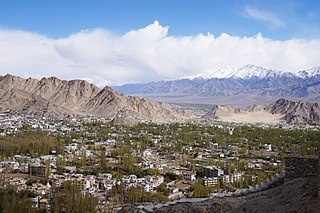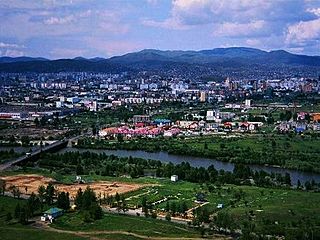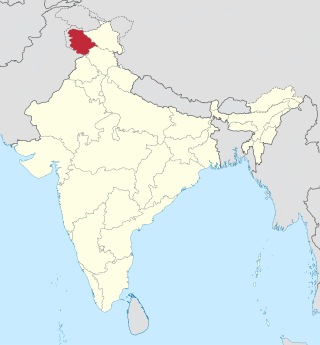Related Research Articles

Kashmir is the northernmost geographical region of the Indian subcontinent. Until the mid-19th century, the term "Kashmir" denoted only the Kashmir Valley between the Great Himalayas and the Pir Panjal Range. Today, the term encompasses a larger area that includes the India-administered territories of Jammu and Kashmir and Ladakh, the Pakistan-administered territories of Azad Kashmir and Gilgit-Baltistan, and the Chinese-administered territories of Aksai Chin and the Trans-Karakoram Tract.

Srinagar is a city in Indian-administered Jammu and Kashmir in the disputed Kashmir region. It is the largest city and summer capital of Jammu and Kashmir, which is an Indian-administered union territory. It lies in the Kashmir Valley along the banks of the Jhelum River, and the shores of Dal Lake and Anchar Lakes, between the Hari Parbat and Shankaracharya hills. The city is known for its natural environment, various gardens, waterfronts and houseboats. It is also known for traditional Kashmiri handicrafts like the Kashmir shawl, papier-mâché, wood carving, carpet weaving, and jewel making, as well as for dried fruits. It is the second-largest metropolitan area in the Himalayas.

Leh is a city in Indian-administered Ladakh in the disputed Kashmir region. It is the largest city and the joint capital of Ladakh. Leh, located in the Leh district, was also the historical capital of the Kingdom of Ladakh. The seat of the kingdom, Leh Palace, the former residence of the royal family of Ladakh, was built in the same style and about the same time as the Potala Palace in Tibet. Since they were both constructed in a similar style and at roughly the same time, the Potala Palace in Tibet and Leh Palace, the royal residence, are frequently contrasted. Leh is at an altitude of 3,524 m (11,562 ft), and is connected via National Highway 1 to Srinagar in the southwest and to Manali in the south via the Leh-Manali Highway.

The Srinagar District is an administrative district of Indian-administered Jammu and Kashmir in the disputed Kashmir region. It is one of the 20 districts of Jammu and Kashmir. Situated in the centre of the Kashmir Valley, it is the second-most populous district of the union territory after Jammu District as per the 2011 national census, and is home to the summer capital city of Srinagar. Likewise, the city of Srinagar also serves as the Srinagar District's headquarters.

Leh district is a district in Indian-administered Ladakh in the disputed Kashmir-region. Ladakh is an Indian-administered union territory. With an area of 45,110 km2, it is the second largest district in the country, second only to Kutch. It is bounded on the north by Gilgit-Baltistan's Kharmang and Ghanche districts and Xinjiang's Kashgar Prefecture and Hotan Prefecture, to which it connects via the historic Karakoram Pass. Aksai Chin and Tibet are to the east, Kargil district to the west, and Lahul and Spiti to the south. The district headquarters is in Leh. It lies between 32 and 36 degree north latitude and 75 to 80 degree east longitude.

Baramulla, also known as Varmul in Kashmiri, is a City and municipality of the Baramulla district of the Indian-administered Jammu and Kashmir in the disputed Kashmir region. It is also the administrative headquarters of the Baramulla district, located on the banks of the River Jhelum downstream from Srinagar, the summer capital of Jammu and Kashmir. The town was earlier known as gateway of Kashmir, serving as the major distribution centre for goods arriving in Kashmir valley through the Jhelum valley cart road.

Kargil or Kargyil is a city in Indian-administered Ladakh in the disputed Kashmir region. It is the joint capital of Ladakh, an Indian-administered union territory. It is also the headquarters of the Kargil district. It is the second-largest city in Ladakh after Leh. Kargil is located 204 kilometres (127 mi) east of Srinagar in Jammu and Kashmir, and 234 kilometres (145 mi) to the west of Leh. It is on the bank of the Suru River near its confluence with the Wakha Rong river, the latter providing the most accessible route to Leh.

Anantnag, also called Islamabad, is the administrative headquarters of Anantnag district of Indian-administered Jammu and Kashmir in the disputed Kashmir region. It is located at a distance of 53 kilometres from the union territory's capital Srinagar. It is the third largest city in Jammu and Kashmir after Srinagar and Jammu with an urban agglomerate population of 159,838 and a municipal limit population of 109,433.

Kashmir Solidarity Day or Kashmir Day is a national holiday observed in Pakistan on 5 February annually. It is observed to show Pakistan's support and unity with the people of Indian-administered Jammu and Kashmir and Kashmiri separatists' efforts to secede from India, and to pay homage to the Kashmiris who have died in the conflict. Solidarity rallies are held in the Pakistani-administered territory of Azad Jammu and Kashmir, Pakistan and by Mirpuri Kashmiris in the United Kingdom.
On 26 May 2008, the government of India and the state Government of Jammu and Kashmir reached an agreement to transfer 99 acres (0.40 km2) of forest land to the Shri Amarnathji Shrine Board (SASB) in the main Kashmir valley to set up temporary shelters and facilities for Hindu pilgrims. This caused a controversy, with demonstrations from the Kashmir valley against the land transfer and protests from the Jammu region supporting it. The largest demonstration saw more than 500,000 protesters at a single rally, among the largest in Kashmir's history.

National Highway 1D, also known as Srinagar-Leh Highway, was a National Highway entirely within the union territory of Jammu and Kashmir and Ladakh in North India that connected Srinagar to Leh in Ladakh. It was one of the only two roads that connected Ladakh with the rest of India, the other being Leh-Manali Highway. The Srinagar-Leh Highway was declared as National Highway in 2006.

Soura, known as Sovur in Kashmiri, is a neighborhood in Indian-administered Srinagar in the disputed region of Jammu and Kashmir. It is located about 9 km north of Lal Chowk, Srinagar on Srinagar-Ladakh Highway in Jammu and Kashmir, India. Soura is noted for Sher-i-Kashmir Institute of Medical Sciences, a multi-specialty hospital. Besides serving as a hospital, it is the medical deemed university of Kashmir valley. Soura is located near Anchar Lake. The whole western side of the area is covered by Anchar Lake. It also hosts a famous Muslim Shrine known as Asar-e-Sharif Jinab Sahib Soura which holds more than 13 holy relics.

The State flag of Jammu and Kashmir was a symbol used in the former Indian state of Jammu and Kashmir between 1952 and 2019, under the special status accorded to the region by Article 370 of the Constitution of India. It was a red-and-white flag with a representation of a plough and three constituent regions of the state. After the abolition of Article 370 in August 2019, this flag lost its official status.

Media in Jammu and Kashmir comprises a diverse landscape of print, electronic and digital media outlets. The region is served by a variety of newspapers, television channels, radio stations, and online news platforms, reflecting the cultural and linguistic diversity of the area.

Jammu and Kashmir is a region administered by India as a union territory and consists of the southern portion of the larger Kashmir region, which has been the subject of a dispute between India and Pakistan since 1947 and between India and China since 1959. The Line of Control separates Jammu and Kashmir from the Pakistani-administered territories of Azad Kashmir and Gilgit-Baltistan in the west and north. It lies to the north of the Indian states of Himachal Pradesh and Punjab and to the west of Ladakh which is administered by India as a union territory.

The Jammu and Kashmir Reorganisation Act, 2019 is an act of the parliament of India containing provisions to reconstitute the Indian-administered state of Jammu and Kashmir into two Indian-administered union territories (UTs) called Jammu and Kashmir, and Ladakh, and becoming effective on 31 October 2019. A bill for the act was introduced by the Minister of Home Affairs, Amit Shah, in the Rajya Sabha on 5 August 2019 and was passed on the same day. It was then passed by the Lok Sabha on 6 August 2019 and it received the president's assent on 9 August 2019.

On 6 August 2019, the Government of India revoked the special status, or autonomy, granted under Article 370 of the Indian Constitution to Jammu and Kashmir—a region administered by India as a state which consists of the larger part of Kashmir which has been the subject of dispute among India, Pakistan, and China since 1947.

The 2019–2021 Jammu and Kashmir lockdown was a preventive security lockdown and communications blackout that had been imposed throughout the Indian-administered union territory of Jammu and Kashmir following the revocation of Article 370 which lasted until February 2021, with the goal of preemptively curbing unrest, violence and protests. Most separatist leaders had and have been detained in the crackdown. The Indian government had stated that the tough lockdown measures and substantially increased deployment of security forces had been aimed at curbing terrorism. The government did not want a repeat of the death and injuries seen during the 2016–2017 Kashmir unrest.
Inter-Services Public Relations of Pakistan produced many media productions. Since the 1990s, the ISPR has been producing dramas, songs, films on military fiction, games and military reality shows. The drama Alpha Bravo Charlie was a hit drama by ISPR during the late 1990s. This is a list of songs, shows, games, films and dramas produced by ISPR.
Pakistan's response to the revocation of the special status of Jammu and Kashmir started immediately after the revocation by India on 5 August 2019.
References
- ↑ "Youm-e-Istehsal Kashmir: India learned how to change regional demography from Israel, says President Alvi". DAWN. 5 August 2020. Archived from the original on 6 August 2020. Retrieved 7 August 2022.
- ↑ "Pakistan to observe 'Youm-e-Istehsal' on Aug 5 in solidarity with Kashmiris". Pakistan Today. 31 July 2020. Archived from the original on 4 August 2020. Retrieved 7 August 2022.
- ↑ "Pakistan to mark Aug 5 as Day of Exploitation to protest abrogation of Article 370". South Asia Monitor. Retrieved 7 August 2022.
- ↑ Sajid, Islamuddin; Latif, Aamir (5 August 2020). "Pakistan observes Kashmir 'exploitation day'". Anadolu Agency . Retrieved 7 August 2022.
- ↑ "After Nepal, Pakistan unveils new political map; Jammu & Kashmir and Ladakh claimed, India retorts". The Himalayan Times . 4 August 2020. Retrieved 7 August 2022.
- ↑ Siddiqui, Naveed (4 August 2020). "In landmark move, PM Imran unveils 'new political map' of Pakistan". Dawn. Retrieved 7 August 2022.
- ↑ "Kashmir Highway symbolically renamed to Srinagar Highway". Global Village Space. 3 August 2020. Retrieved 7 August 2022.
- ↑ "Kashmir Highway renamed as 'Srinagar Highway'". Daily Times. 4 August 2020. Retrieved 7 August 2022.
- ↑ "Pakistan Army releases new song to mark Kashmir's 'Youm-e-Istehsal'". www.geo.tv.
- ↑ "ISPR releases new song on 'Youm-e-Istehsal,' in solidarity with the Kashmiris". Latest News - The Nation.
- ↑ Desk, Web (2 August 2020). "ISPR releases new song expressing solidarity with Kashmiris on eve of Youm-e-Istehsal". ARY NEWS.